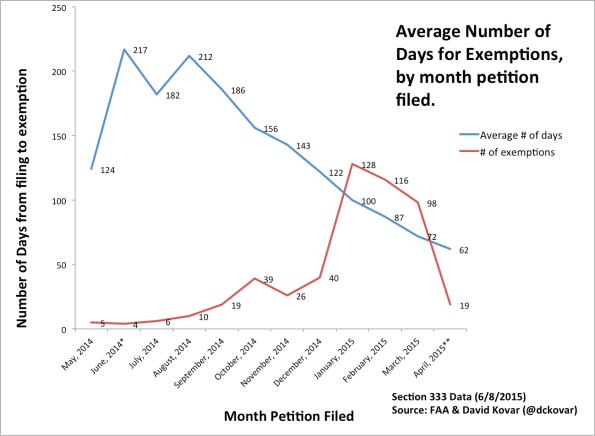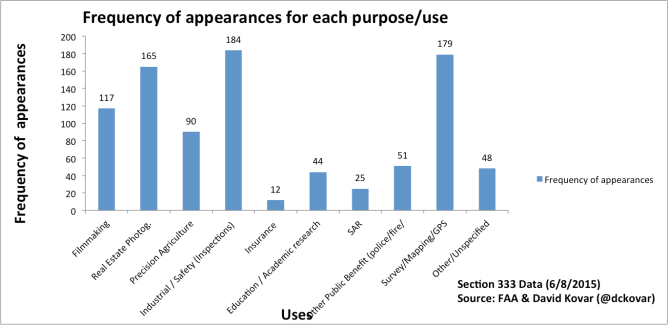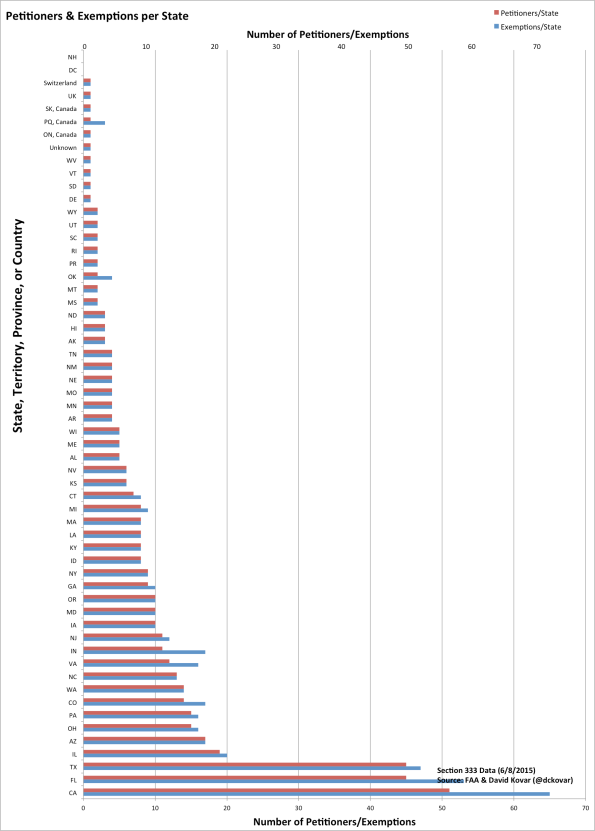Analysis of FAA 333 exemption grants, it isn’t all about photography
There is a lot of uncertainty in the US UAV market due to lack of data. We do not have accurate sales data, number of hours flown, number of incidents, or even a good definition of what a UAV incident is. However, there is one really good UAV related dataset: Authorizations Granted Via Section 333 Exemptions. This is the FAA’s list of exemptions granted to allow commercial UAV operations.
Let’s ask some simple questions of the data, leaving the best for last. (If you don’t want to read the whole thing, please do pay attention to the last question.)
- How many petitions/exemptions by state?
- What was elapsed time between filing of petition and granting of exemption?
- How many petitions were there for each industry/purpose?
Before going forward please understand this – this post is not in any way a comment on the legality or appropriateness of the 333 process and it does not in any way imply that commercial operations without a 333 are in some way illegal or “worse” than operations with a 333 exemption.
Number of 333 exemptions granted per state:
It is worth noting that several exemptions came in from outside the US, most notably Canada, but also one from the UK and one from Switzerland. The top ten states by number of petitioners are:
| State | Exemptions/State | Petitioners/State |
| CA | 65 | 51 |
| FL | 53 | 45 |
| TX | 47 | 45 |
| IL | 20 | 19 |
| AZ | 17 | 17 |
| OH | 16 | 15 |
| PA | 16 | 15 |
| CO | 17 | 14 |
| WA | 14 | 14 |
| NC | 13 | 13 |
Note: Several petitioners filed multiple petitions.
California, Florida, and Texas clearly lead the pack in terms of companies authorized by the FAA to conduct commercial UAV operations. New Hampshire and DC both have zero authorized companies.
The full chart is at the bottom of this post.
Time between filing and exemption granted:
This is an easy one. We know the FAA has picked up the pace and the data clearly supports this:
*June 2014 Includes 2 exemptions which skew the average high: Yamaha at 322 days, Amazon at 270. **April submissions only include those for which exemptions were granted on or before June 8, 2015.
Not only are we seeing more exemptions get filed, we’re seeing the exemptions in the queue get processed faster. Clearly a good thing for those who want to go the 333 route.
It is not all about photography:
All too often we hear that “UAVs are only used for photography,” usually referring to media, real estate, and filmmaking. The data shows that petitioners are interested in using UAVs for many other purposes.
A note on the analysis – there is no single source of UAV use cases. Petitioners were relatively consistent, but some interpretation was required:
- “Filmmaking” includes not only motion picture industry movie-making, but also private event filming, newsgathering, business/tourism, etc.
- “Real Estate Photography” is frequently described formulaically as “academic community awareness” (so people know where to find Main Street, actually, not “academic” in the sense of teaching).
- “Precision Agriculture” almost invariably is accompanied by “Survey/Mapping/GPS” use as well.
- “Industrial Safety (Inspections)” was inclined towards both specific inspection objectives, such as bridges and flare stacks, and industrial activities which require industrial safety, such as mining, construction, civil engineering projects, public utilities & their infrastructure, and so forth.
- “Insurance” was very specifically tied to claims analysis and risk management, and insurance companies were usually the petitioners though there was at least one third party.
Not only are there many other intended purposes other than photography, industrial inspections and surveying both exceed filmmaking and real estate exemptions granted. Let me say that again, the FAA 333 exemption data shows that more commercial operations are interested in inspection work that real estate photography work.
The data also suggests something else – there are a lot of people quietly flying fixed wing UAVs. The public, media, and government often associates “drones” with multi-rotors. A lot of precision agriculture, mapping and SAR applications require fixed wing platforms for long duration, wide area operations.
Summary:
There is more interesting data to mine from the 333 exemption data set (drop me a line if you have questions that it might answer). Hopefully what we present here will serve two purposes:
- Put some public and media misconceptions to rest.
- Show that we need more good data on UAV applications, incidents, and regulation in the US as well as globally
The second point is very important to me – it is hard to make good decisions about regulation, law, investment, operations, etc., without good data to help inform the decision making process.
-David Kovar
Availability of data:
Our raw data extracted from the 333 data set is available to academic institutions and media organizations at no cost providing that appropriate attribution is included in any resulting analysis or reporting.
Petitioners and Exemptions per State
The following graphic was too large to include above.




Thrilled to see Illinois in the top 5. A few of us are trying to pitch a tech park on the north side of town. UAV related companies would be a great fit. Maybe we can start a rebirth of the silicon prairie.
I applied for a 333 waiver towards the end of April. I am really hopeful that we will receive our waiver by the end of July. With only 14 requests in Washington, I think we will have a good marketplace in which to play, er, work. Thank you so much for your analysis. It is very well thought out and well presented.
You might want to consider joining our local AUVSI Chapter, http://auvsiheartland.org/
Nicely done. Thank you.
David, Thank you very much for this UAV analysis. I am interested in the use of UASs for disaster response and emergency management. I’d like to see more about your work. Regards
Rick,
Thank you for the kind words. I’m slowly working with local agencies on SAR, DR, and emergency management. Most of the barriers are not technical, rather they are regulatory or political. UAVs clearly can play a major role in post-disaster imagery and mapping, but getting over the regulatory and privacy hurdles is hard.
I’ll try to write up a more thoughtful and detailed piece on the current state of affairs.
-David
This is incredible. Great insights in comparison to November of 2014 (25 +/-) approved to current day 648 approved.
following up on Rick Lusk’s for uses, what NOT to do is fly a UAV during ANY fire, CalFire had to call off all air operations at a wildfire this week as a ‘UAV pilot’ was flying in controlled airspace and the tanker had to make a drastic flight maneuver to avoid an airstrike… thanks and look forward to more info David
Absolutely agree. (15+ years of SAR and disaster response experience, so some direct experience with emergency air operations.) I’ve had discussions with civilians about this issue and the viewpoint is usually “We’re not any risk to aviation assets.” or “We have a right to film.” or “What could a drone possibly do to a tanker?”.
Hi David, I hate to come in last on thanking you, but great work you have done, especially for those that have been researching this topic for hundreds of hours, as I have. I am retiring from the Federal Government, and my wishes are to pursue this business model. Unfortunately, I have seen conflicting information on operator (PIC) certification requirements. Even the local aviation schools don’t know how to respond. I am not a pilot, but do I need to be? Then I see on some sites that the FAA is curving the language somewhat to exclude “micro” UAS, which weighs less than 4 pounds I think, from having to obtain a sport or private pilot license. Would you be able to weigh in on exactly what a non-pilot needs, as for operator certification, in order to operate a UAS? Thank you again sir for your efforts on this analysis.
Dan
Dan,
The FAA is asking for voluntary compliance. If you choose to comply, then you need to have a minimum of a sport pilot license. Once the final regulations are in place, best guess is late 2016 or early 2017, there should be a special UAV certification.
Most people are flying without a pilot’s license, including many commercial operators. If you fly safely – below 500 feet, away from people, not in controlled airspace, etc – there is very little chance that anyone will notice or object. At some point, the FAA will crack down, but who knows when?
There is some expectation that the FAA will carve out a non-commercial micro-UAS category with little to no regulation.
-David
Thank you David. Sorry, first chance I had to respond after last night. I don’t mean to clutter your blog with all of this, but I pasted a portion of the FAA Q&A down below. This is still somewhat confusing. First, the aircraft (UAS Quadcopter), will not require an airworthiness certificate, gathered from my own research. So their first line below states that a pilot certificate is not required. Then it goes on to say in the last two sentences, that an airman certificate would be required. I don’t expect for you to play attorney on this, and I apologize if it seems as if I am putting you on the spot, but if you are in communications with anyone in the FAA, I thought I would try once more for clarity on this. I just simply wish to be legal, and run a business without the fear of being fined.
—————————————————————————————————–
Is an FAA-issued pilot certificate required to operate a civil UAS under an experimental airworthiness certificate or a grant of exemption under Section 333?
If the aircraft is issued an airworthiness certificate, a pilot certificate is required. 5
Pilot certification requirements for petitions for exemption under Section 333 are evaluated on a case-by-case basis. While Section 333 grants the Secretary of Transportation flexibility with regard to airworthiness certification requirements, it does not grant the Secretary any flexibility with regard to airman certification standards as outlined in Sections 44703 and 44711 of Title 49 of the United States Code (49 USC). An FAA airman certificate is required to operate an aircraft in the National Airspace System.
——————————————————————————————————
Greetings,
I do not even play a lawyer on TV, but ….
1) Currently, you must have at least a sport pilot’s license to act as PIC on a UAV in the US.
2) All of the grants I’ve seen have waived the airworthiness certificate.
I can recommend some very good lawyers if you are interested. Sorting through this stuff is annoying, certainly!
-David
Thanks again. Well, it seems that if you wish to operate in this business, you’d better prepare for a large investment, probably a minimum of $12-20K when you consider top line equipment, pilot license, marketing, etc. Banks probably don’t even have this business model in their little black books yet. Not only the amount of money, but the time it will take to even get all of the legal agenda out of the way, which can amount to roughly 3-4 months or more, considering your flight training and the time it takes to go through the Section 333, which can only be initiated (after) you have your pilot license in hand. Then once you have that out the way, and if you are approved through the exemption, coa, etc., the landscape would have likely changed, as for FAA regulations, city, county, state, etc. Seems as if this has turned into a circus. Big money is at the controls, obviously. Thanks for your input, and I will pass on the attorneys, that is pushing the budget even farther. Enjoy your week sir, and keep up the good work.
You can get started with a Phantom Vision 2+, DroneDeploy, and a web site for simple mapping. You can leave off DroneDeploy if you just want to do real estate photography. As long as you fly safely, it appears that the FAA will not bother you.
To build a viable business and comply with the FAA, $12K and up is about right.
Many people who want to comply are hiring pilots and skipping the training time and cost.
It is definitely the Wild West at the moment.
Happy to help, and good luck!